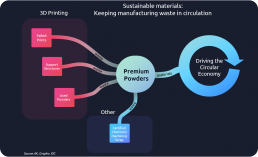There are many discussions about whether 3D printing (or additive manufacturing) is a more sustainable alternative to traditional manufacturing. We could write pages and pages about it, but instead, let’s take a look at a quick summary of how 3D printing affects people and the environment.
Is 3D Printing More Sustainable than Traditional Manufacturing?
There are four main indicators:
Waste
- Some technologies, such as FDM/FFF, that use filament can reduce plastic waste by only using the material needed for the production of the final part and minor support structures.
- Other technologies, such as binder jet/powder bed, can create more waste as the excess powder cannot always be reused.
Emissions
- Ultrafine particles produced during FDM printing are hazardous to health.
- There are a number of office-ready 3D printers on the market with sophisticated filtration systems that can capture all toxic particles.
- Distributed additive manufacturing can reduce emissions from shipping by printing parts on site.
Energy
- Current 3D printing methods use the same amount of energy as traditional manufacturing, according to Richard D’Aveni’s The Pan-Industrial Revolution (Boston, 2018).
- 3D printed solar cells for solar panels show higher efficiency rates and are more cost-effective to produce, which may speed up the transition to alternative energy sources.
Materials
- The 3D printing industry accounts for a large quantity of plastic by-products (failed prints, structural support, etc.).
- Many plastics can be recycled and reused, and some 3D printing materials are biodegradable.
- Metal materials and powders for 3D printing can also be kept in circulation.
As with most things, there are two sides to each factor. Taking a limited view and focusing only on the final part, there’s no need for such heavy post-production such as CNC milling, which strips down excess material. But failed prints and support structures or powder, depending on the process, are by-products of 3D printing and may go to waste.
The additive manufacturing process does not use less energy than traditional manufacturing — according to some studies, it was actually 50–100 times higher. But it does have lower emission levels, and even though recyclable materials can be used for 3D printing, the technology itself does not guarantee that this will always be the case.
Nonetheless, more manufacturers are adopting sustainable practices, and some are hoping to take it to the next level or, should we say, planet?
3D Printing Rockets on Mars … Sustainably, of Course
Sustainable production is a hot topic among heavy industries such as manufacturing, automotive, and aerospace. Many industries are already using 3D printing and are now looking to augment their efforts by switching to sustainable materials.
Californian aerospace manufacturer Relativity Space announced in June that it had partnered with sustainable 3D printed metals provider 6K to produce rocket components from reusable materials. Relativity is using large-scale 3D printing to manufacture the world’s first entirely 3D printed rocket, Teran 1, with a hundredfold reduction in the number of components compared with traditional rockets.
Besides improving sustainability indicators, reducing the number of parts in engine combustion chambers, reaction control thrusters, turbopumps, igniters, and vehicle pressurization systems also enhances the spacecraft’s reliability. Relativity’s not-so-secret ambition is to someday 3D print a rocket on Mars.

Most 3D printing technologies already reduce waste by using almost 100% of the material for part production. Metal 3D printing such as powder-bed fusion, however, can result in up to 70% material waste. By bringing in recycled materials, manufacturers can move one step closer to green manufacturing.
6K Additive is a materials provider promising “zero loss” of materials by using microwave plasma technology at temperatures up to 6,000°F (around 3,316°C). The sustainability element to this process creates a closed loop by following the principles of circular economy by reusing scrap metals and failed prints to produce premium powders used for 3D printing of new parts. Compared with conventional powder production methods, 6K’s plasma technology reduces energy consumption by two-thirds and creates no wastewater.

Key Takeaways
There’s a lot of debate about whether 3D printing is actually a more sustainable option to traditional manufacturing. In short, it depends on the specific use, and as with any technology, the monitoring of key performance indicators is key.
3D printing can potentially help manufacturers to reduce their environmental footprint, especially when integrated in the overall sustainability strategy and adhering to circular-economy principles.
If you want to learn more about this topic or have any questions, please contact Galina Spasova, or head over to https://www.idc.com/eu and drop your details in the form on the top right.

